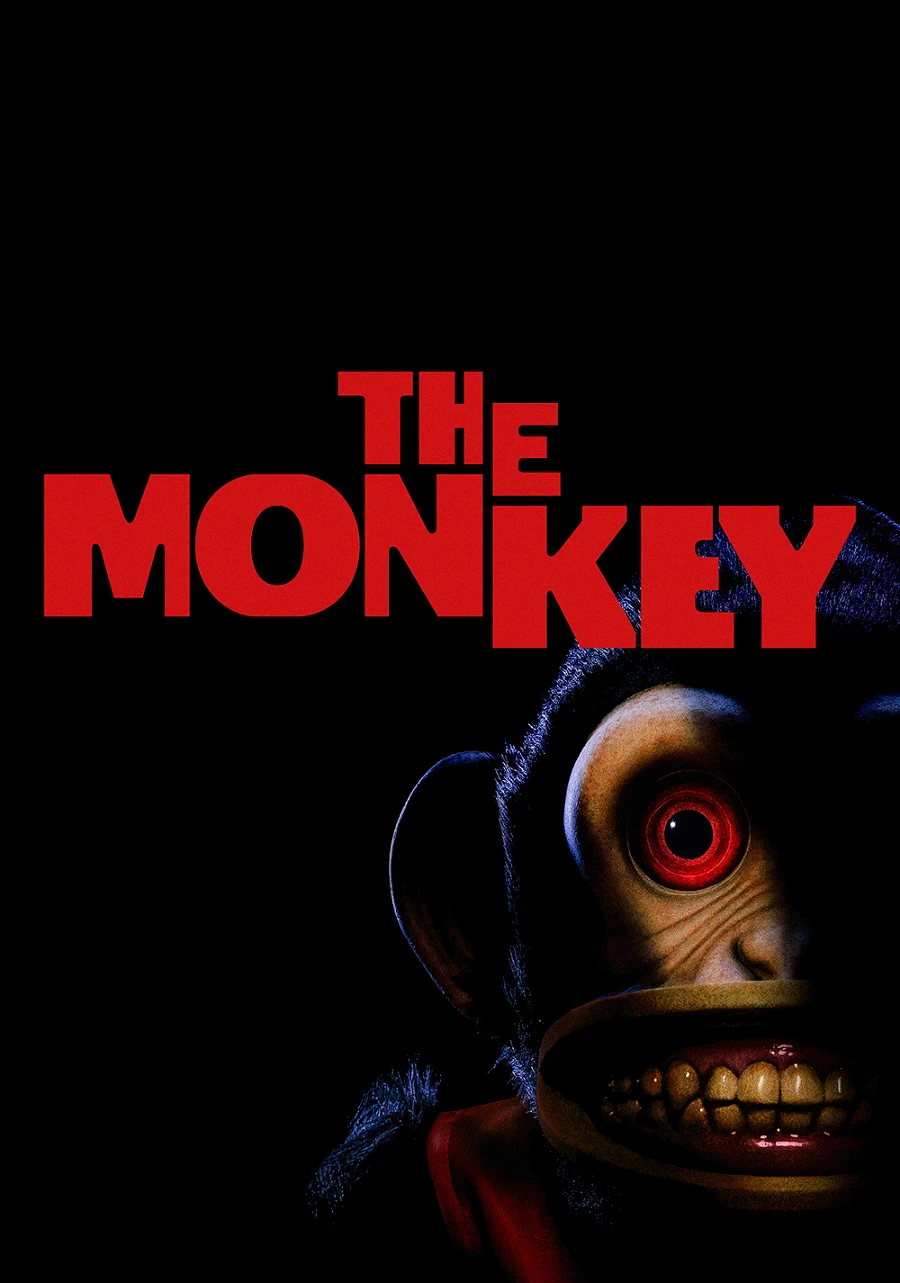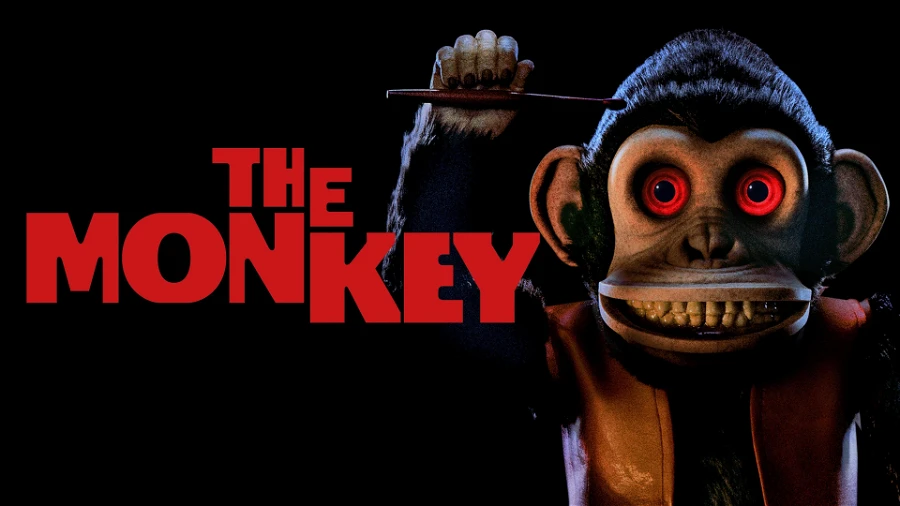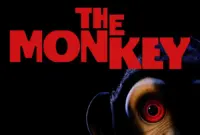The Monkey (2025) is a highly anticipated horror movie adaptation of Stephen King’s chilling short story. Directed by Osgood Perkins, the film is already making waves among horror enthusiasts and fans of King’s twisted storytelling. In this in-depth guide, we’ll explore everything you need to know about The Monkey movie—from plot and cast to its behind-the-scenes production details, fan theories, and its place in the evolving horror genre.

1. Overview of The Monkey (2025)
The Monkey (2025) is a supernatural horror movie that follows the terrifying consequences of a cursed monkey toy that brings death each time it claps its cymbals. Rooted in Stephen King’s knack for blending everyday objects with deep psychological horror, the film dives into generational trauma, repressed memories, and the fear of inescapable fate.
Produced by Atomic Monster and Blumhouse, The Monkey is already touted as a potential horror classic, aligning with the recent trend of slow-burn psychological horror films.
See Also: Mickey 17 (2025): Full Movie Review, Cast, Plot, and Everything You Need to Know
2. Origin of the Story: Stephen King’s Short Fiction
Stephen King’s original story The Monkey was first published in 1980 in Gallery magazine and later featured in his 1985 short story collection Skeleton Crew. The narrative centers on two brothers who discover their father’s old toy monkey—a sinister item that seems to be responsible for a series of tragic deaths.
King masterfully creates tension through subtle dread rather than overt scares, a quality that has been preserved and amplified in the 2025 movie adaptation.
3. Director and Screenplay Insights
Osgood Perkins, known for his atmospheric and cerebral horror films like The Blackcoat’s Daughter and Gretel & Hansel, directs The Monkey. Perkins’ distinct visual style and emphasis on mood over gore make him the perfect fit for adapting King’s story.
The screenplay is written by Perkins himself, ensuring a cohesive vision from script to screen. Perkins reportedly worked closely with King during the adaptation process, maintaining key themes while adding new layers of complexity.
4. Cast and Characters
The movie stars Theo James as Hal, the older of the two brothers, whose childhood experiences with the monkey toy continue to haunt him. James delivers a nuanced performance that reflects a man unraveling under the weight of guilt and fear.
Elijah Wood plays his younger brother, Bill, who also shares the traumatic past but copes in very different ways. The dynamic between the two actors adds depth to the narrative, showcasing the emotional toll of the cursed object.
Supporting roles include:
- Tatiana Maslany as Dr. Margaret Ellis, a psychologist studying trauma-induced hallucinations.
- David Dastmalchian as the antique dealer who unwittingly reintroduces the monkey into the brothers’ lives.
- A cameo by Stephen King as a mysterious janitor who delivers cryptic warnings about the monkey.
5. Plot Summary (Spoiler-Free)
Set in two timelines, The Monkey (2025) weaves the past and present of the Holland brothers, Hal and Bill. When they were children, they discovered an eerie toy monkey in their father’s attic. Whenever the monkey clapped its cymbals, someone nearby would die. After a series of terrifying events, the monkey was locked away and seemingly forgotten.
Decades later, Hal discovers the toy again after his father’s death. Strange occurrences begin anew, and Hal must confront the past to protect his family from the same fate. The film masterfully builds suspense, mixing supernatural horror with emotional depth.
6. Full Plot Breakdown (Spoilers Ahead)
Warning: Spoilers begin here.
The film opens with a flashback to the 1970s, where young Hal and Bill first encounter the monkey. Their pet dies, followed by a neighbor and eventually their mother. Terrified, the boys hide the monkey in a box and toss it into a lake.
In the present, Hal finds the monkey among his late father’s belongings. At first, he dismisses it as coincidence when a co-worker dies suddenly. But the pattern quickly reemerges—each time the monkey claps, someone close to Hal dies.
Desperate, Hal seeks help from Dr. Ellis, who uncovers repressed memories of abuse and loss tied to the monkey. It’s revealed that the toy may be a vessel for a malevolent spirit or perhaps a physical manifestation of inherited trauma.
The climax sees Hal returning to the lake where the monkey was once discarded. But the monkey fights back in nightmarish hallucinations and manifestations. In the end, Hal sacrifices himself to ensure the monkey’s destruction, breaking the cycle of death.
Bill, who arrives too late to save Hal, watches as the lake consumes both his brother and the toy. The final shot shows a child finding cymbals at the water’s edge, suggesting the curse may never end.
7. Key Themes and Symbolism in The Monkey (2025)
The Monkey (2025) is more than a chilling horror story—it’s a layered exploration of generational trauma, grief, guilt, and the haunting persistence of childhood fears. Osgood Perkins infuses the film with rich symbolism that elevates it from a simple cursed-object tale into a profound psychological study.
A. Generational Trauma
One of the film’s core themes is the transmission of trauma across generations. The cursed monkey symbolizes unresolved pain passed down from parent to child. Hal and Bill’s experiences are rooted in their father’s mysterious behavior and secrets, which manifest physically through the toy. As adults, the brothers are forced to confront not just a supernatural threat, but a legacy of silence and fear.
This is especially evident in how the monkey seems to “activate” during moments of emotional vulnerability. It feeds off suppressed memories and buried guilt, making the horror feel deeply personal.
B. The Monkey Toy as a Symbol of Repressed Memory
The monkey toy is a perfect metaphor for repressed trauma. It lies hidden for years, only to return with deadly consequences. The act of the monkey clapping its cymbals parallels the sudden and often uncontrollable resurgence of traumatic memories. Each “clap” is a trigger, unleashing pain that the characters thought they had buried.
C. Death and the Inevitability of Fate
The inevitability of death looms large in The Monkey. Characters who encounter the toy seem fated to suffer, no matter how they try to escape or rationalize the events. This suggests a broader commentary on how trauma, if left unaddressed, becomes an inescapable force. The monkey becomes a symbol not only of death, but of the futility of denial.
D. Duality of Time and Memory
The dual timeline—shifting between childhood and adulthood—underscores the persistence of memory. Events from the past bleed into the present, suggesting that time does not heal all wounds. Perkins uses visual cues such as reflections, mirrors, and overlapping audio to illustrate how the past is always present.
E. Family, Guilt, and Protection
Hal’s journey is rooted in a desire to protect his loved ones, even as he becomes increasingly isolated and paranoid. His guilt over past events—both real and imagined—drives him toward the climax. The film explores how guilt can distort perception and lead to self-sacrifice, as seen in Hal’s tragic end.
F. Isolation and Mental Deterioration
As the monkey’s influence grows, Hal becomes more isolated. Friends and family begin to doubt his sanity. The film blurs the line between reality and delusion, making viewers question whether the horror is external or internal. This descent into madness is a staple of psychological horror and is portrayed with nuance and tension.
G. Religious and Occult Undertones
Though not overt, the film hints at occult origins for the monkey toy. Ancient symbols appear etched on its internal mechanism. A backstory involving a cursed craftsman and a forgotten ritual is briefly mentioned, adding depth and mystery. These details hint that the monkey might be more than just a cursed object—it may be a conduit for something ancient and evil.
H. Symbolic Use of Water
Water appears frequently in the film—rainstorms, bathtubs, lakes. It symbolizes memory, emotion, and the subconscious. The lake where the monkey is first discarded and ultimately destroyed represents both origin and oblivion. It’s a place where trauma is hidden but not erased.
I. The Final Symbolism: Hope or Endless Cycle?
The ending, where a child finds part of the monkey at the lake’s edge, suggests a cyclical curse. It leaves audiences with a chilling question: can trauma ever truly be eradicated, or does it simply wait for the next generation? The ambiguity reinforces the film’s psychological depth.
8. Behind the Scenes: Filming and Production
The Monkey (2025) was filmed across several atmospheric locations in Canada and New England, which provided the perfect gloomy and haunting backdrop. The production focused on creating a sense of isolation and dread using practical effects, dim lighting, and vintage props that evoke the 1970s and early 2000s timelines.
Osgood Perkins emphasized a collaborative process on set, working closely with actors to elicit raw, emotional performances. The team reportedly used minimal CGI, favoring practical puppetry and sound design to bring the monkey to life.
9. Special Effects and Cinematography
The film’s effects are both subtle and impactful. Cinematographer Julie Kirkwood used wide-angle shots and slow zooms to build tension, while the monkey itself was a practical prop enhanced with subtle animatronics. Sound cues—especially the clapping of cymbals—were layered with ambient dread to create psychological discomfort.
The decision to avoid jump scares in favor of sustained tension helps The Monkey stand out from typical horror fare. The film’s muted color palette adds to its sense of unease.
10. Soundtrack and Score
Composer Mark Korven, known for The Witch and The Lighthouse, created an eerie and minimalist score. The music relies heavily on dissonance and silence, using violins, water glasses, and reversed piano notes to emphasize dread.
The monkey’s clapping sound was mixed to echo at specific frequencies that provoke anxiety, a technique borrowed from psychoacoustic theory.
11. Release Date and Distribution
The Monkey premiered at the Sundance Film Festival in January 2025 and saw a wide theatrical release in March 2025, distributed by Universal Pictures. It quickly gained traction among horror circles and fans of Stephen King adaptations.
Streaming rights were acquired by Peacock, with the film slated for exclusive digital release in June 2025.
12. Critical Reception
Critics praised the film for its psychological intensity, performances, and respectful adaptation of King’s original work. Rotten Tomatoes scored it at 88%, while Metacritic reported a 79/100 score.
Many reviewers compared it favorably to Hereditary and The Babadook, citing its emotional depth and lack of conventional horror tropes.
13. Audience Reactions and Fan Theories
Audiences responded positively, especially longtime fans of Stephen King. Fan theories abound about the monkey’s true nature—some believe it is a demon, while others argue it’s a projection of the brothers’ trauma.
Reddit threads have dissected the film’s hidden symbols, including the recurring motif of broken clocks, which many interpret as a metaphor for frozen time.
14. Comparison to the Original Story
While the film stays true to the essence of King’s short story, it expands significantly. The original narrative was tighter and more ambiguous. Perkins adds layers of emotional complexity, new characters, and a dual timeline structure.
The movie also offers a definitive climax and resolution, while King’s story leaves more to the imagination.
15. Other Stephen King Adaptations
The Monkey joins a long list of successful Stephen King adaptations including It, The Shining, Pet Sematary, and Gerald’s Game. Like Doctor Sleep, this film balances horror with psychological themes and emotional resonance.
Fans and critics alike place it among the better adaptations thanks to its fidelity to the source material and creative expansion.
16. Analysis of the Horror Elements
The horror in The Monkey is slow-burning and existential. Rather than rely on gore or jump scares, it builds dread through pacing, atmosphere, and emotional stakes.
The monkey’s design is unnerving but not grotesque, amplifying the fear of the familiar turned hostile.
17. Psychological Depth and Narrative Structure
Told through non-linear storytelling, the film explores how trauma distorts memory and perception. Flashbacks are interwoven with present-day scenes to reflect the protagonists’ psychological unraveling.
Hal’s descent into paranoia mirrors his father’s, creating a haunting sense of destiny and cyclical trauma.
18. The Role of the Monkey Toy
The monkey is both literal and metaphorical. It’s an object imbued with supernatural evil, but it also represents emotional baggage that characters try to suppress.
It acts almost like a character itself—its presence is always felt, even when offscreen.
19. Impact on the Horror Genre in 2025
The Monkey signals a continued trend toward thoughtful, character-driven horror. It avoids clichés and instead focuses on the psychological cost of fear.
The film’s success may influence future horror films to emphasize emotional depth over spectacle.
20. The Ending Explained
Hal sacrifices himself in an attempt to destroy the monkey, tying his fate to the cursed object. But the final shot—a child discovering the cymbals—implies the evil may persist.
The ending is ambiguous, leaving viewers to interpret whether the curse was truly broken or merely passed on.
21. Easter Eggs and Hidden Details
Eagle-eyed viewers have spotted several Easter eggs:
- A book titled Skeleton Crew on Hal’s bookshelf.
- A framed picture of a clown resembling Pennywise in the antique shop.
- A janitor (played by King) muttering the line “All things serve the Beam,” referencing the Dark Tower universe.
22. Future of The Monkey Franchise
Given the film’s success, rumors of a sequel or prequel are already circulating. A potential origin story for the monkey’s creation could delve into darker, occult themes.
Blumhouse has hinted at developing an anthology series around cursed objects, with The Monkey as the pilot.
23. Final Verdict and Review
The Monkey (2025) is a triumph of horror filmmaking. It combines classic Stephen King dread with Osgood Perkins’ eerie style and strong performances.
Its layered themes, haunting visuals, and emotional resonance make it one of the standout horror films of the decade.
24. Frequently Asked Questions (FAQs)
Q: Is The Monkey based on a true story? A: No, it’s based on a fictional short story by Stephen King.
Q: Where can I watch The Monkey (2025)? A: It’s available in theaters and will stream on Peacock in June 2025.
Q: Who plays Hal and Bill? A: Theo James plays Hal, and Elijah Wood plays Bill.
Q: Is the monkey toy real or CGI? A: It’s a practical prop with some animatronic features.
Q: Will there be a sequel to The Monkey? A: While unconfirmed, Blumhouse has hinted at franchise potential.
25. Source and Reference
IMDB, https://www.imdb.com/title/tt27714946/



2 comments